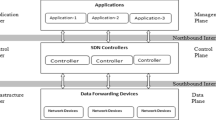Abstract
The growing needs of multimedia communications are leading to new developments in providing real-time communication with guarantees. Several extensions have been proposed for different layers of the Open Systems Interconnection Reference Model to accomodate these needs. In this paper, we study methods for guaranteeing delay jitter bounds for high-speed networks in the network and application layers of this model. The method proposed for the network layer provides distributed jitter control. The method proposed for the application layer allows the destination application to control delay jitter. We use a simulation to compare the effects on delay jitter in each method for various scenarios, such as constant bit rate, cross traffic, and bursty data. In addition, the buffer space requirements for accommodating real-time channels are monitored at each node in the network.
Similar content being viewed by others
References
Campbell A, Coulson G (1992) A continuous media transport and orchestration service. ACM SIGCOMM ′92, pp 99–110
Banerjea A, Mah BA (1991) The real-time channel administration protocol. Proceedings of the 2nd International Workshop on Network and Operating System Support for Digital Audio and Video (NOSSDAV ′91), Springer Verlag, Heidelberg, Germany, pp65–72
Ferrari D (1990) Client requirements for real-time communication services. IEEE Commun Magazine 28:65–72
Ferrari D (1992a) Real-time communication in an internetwork. Technical Report TR-92-001, International Computer Science Institute, Berkeley, Calif
Ferrari D (1992b) Delay jitter control scheme for packet-switching internetworks. Comput Commun 15, No. 6, July/August 1992, pp 367–373
Ferrari D, Verma D (1990a) Buffer Space Allocation for Real-Time Channels in a Packet Switching Network. Tenet Group, Berkeley, Calif
Ferrari D, Verma D (1990b) Real-time communication in a packet-switching network. Proceedings of the 2nd International Workshop on Protocols for High-Speed Networks, Palo Alto, CA, pp 263–278
Ferrari D, Banerjea A, Zhang H (1992a) Network support for multimedia — a discussion of the Tenet approach. Technical Report TR-92-072, International Computer Science Institute, Berkeley, Calif
Ferrari D, Ramaekers J, Ventre G (1992b) Client-network interactions in real-time communication environments. Tenet Group, Berkeley, Calif
Golestani SJ (1991) A framing strategy for congestion management. IEEE J Selected Areas Commun 9, No. 7, pp 1064–1077
Partridge C (1991) Isochronous applications do not require jitter-controlled networks. Request for Comments, RFC 1257
Ramaekers J, Ventre G (1992) Quality-of-service negotiation in a real-time communication network. Technical Report TR-92-023, International Computer Science Institute, Berkeley, Calif
Shepherd D, Salmony M (1990) Extending OSI to support synchronization required by multimedia applications. Comput Commun 13:399–406
Verma D, Zhang H, Ferrari D (1991) Delay jitter control for realtime communication in a packet switching network. Proceedings of the TriComm ’91, IEEE, Chapel Hill, N.C., pp 35–43
Wolfinger B, Moran M (1991) A continuous media data transport service and protocol for real-time communication in high speed networks. Tenet Group, Berkeley, Calif
Author information
Authors and Affiliations
Additional information
Sumathi Kadur completed a Bachelor of Engineering degree in Computer Science at Bangalore University. She then worked for Tata Consulting Engineers for 3 years as a Specialist Engineer in Communication Software. She received a Master of Science degree in Computer Science from Arizona State University in 1994. She is now working as a Network Software Engineer at Cell-net Data Systems.
Forouzan Golshani is a Professor of Computer Science and Engineering. Formerly, he was with the Department of Computing at Imperial College, University of London, UK. His research interests include multimedia computing, artificial intelligence, and database systems. His industrial experience has been with Bull Worldwide Information Systems, Intel, McDonnell Douglas, and Honeywell. Dr. Goshani is the Review Editor for IEEE MultiMedia. He received his PhD in Computer Science from the University of Warwick, England in 1982.
Bruce R. Millard is an Associate Research Scientist and the Director of System Integration and Management with the Information Technology Division of Arizona State University (ASU). He received his PhD in Computer Science from ASU in 1986. His earlier degrees are from Washington State University. His research and teaching interests are in distributed operating systems, the communications structure and programming of distributed computing systems, computer communication protocols, operating systems, computer networks, UNIX kernel internals, computer communication programming, and the structure and programming of distributed systems.
Rights and permissions
About this article
Cite this article
Kadur, S., Golshani, F. & Millard, B. Delay-jitter control in multimedia applications. Multimedia Systems 4, 30–39 (1996). https://doi.org/10.1007/s005300050010
Issue Date:
DOI: https://doi.org/10.1007/s005300050010




